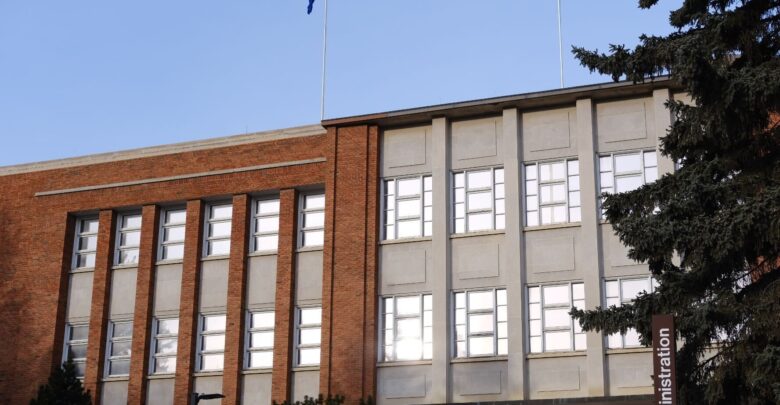AASUA and U of A begin negotiations for new collective agreement
“It takes a long-time to build a world class university, which the U of A is, but that standing can be squandered in a moment by reckless budgetary decisions," AASUA president says.
 Macy Wong
Macy WongThe current collective agreement between the Association of Academic Staff of the University of Alberta (AASUA) and the U of A is set to expire on June 30. On March 5, AASUA and the U of A exchanged opening proposals, which began negotiations for the next collective agreement.
Current AASUA president Gordon Swaters has worked as a faculty member at the U of A since 1986. Currently, he is a professor of mathematical and statistical sciences. In an interview with The Gateway, Swaters said administration has lost sight of the university’s core mission of high-quality teaching and research over the past five years. As a result, they have disrespected academic staff and students, he said.
Staff and students have faced budget cuts, academic restructuring, and the COVID-19 pandemic, Swaters said. Despite this, “our employer won’t even hand us an oar to paddle through the torrent that the tides of inflation have exerted on our salaries and benefits.”
“Enough is enough. AASUA will do whatever is necessary to protect the world-class university education we give our students, and by extension, to all Albertans.”
Proposed salary increases are insufficient to combat inflation, Swaters says
The proposed salary increases in the university’s opening proposal are insufficient to combat inflation, Swaters said. Additionally, the U of A’s average faculty salary would be below the average salaries of most U15 schools, Swaters said. U15 is an association of 15 leading Canadian research universities, including the U of A.
From 2021-22, the University of Toronto and the University of British Columbia had the top-paid academic faculty, Swaters said. During those years, he said the U of A was ninth.
“From about 2010-15, we were in the top three in terms of our average faculty salary. We were consistent with our salaries with the product we deliver,” Swaters said.
According to Swaters, the portion of the U of A’s operating budget that is allocated toward academic teaching salaries is the lowest in U15. It is also below average for other post-secondary institutions in Alberta, he added. Swaters said the university is diverting financial resources for other purposes.
“Our salaries are supporting non-academic related functions of the university. This has to come to a stop.”
If the U of A does not provide competitive compensation in comparison to other top Canadian universities, Swaters said the university won’t retain existing academic staff.
“The U of A’s aspiration is to be a top three institution. It means that we will not be able to retain the existing academic staff members who have created the conditions by which we are a top five institution.”
If staff leave for better paying positions, the quality of education the U of A offers will diminish, Swaters said.
“It takes a long-time to build a world class university, which the U of A is. But that standing can be squandered in a moment by reckless budgetary decisions.”
University needs to live up to EDI commitments, Swaters says
AASUA is insisting the university fulfills its equity, diversity, and inclusion (EDI) commitments in its treatment of contract academic staff. Currently, almost one-third of academic staff have term-limited contracts, Swaters said. Despite this, they teach 50 per cent of undergraduate courses. According to Swaters, the university’s opening proposal does not mention employment security for “precariously-employed members.”
“It’s time for the university to align its actions and budget priorities with its alleged commitment to the principles of EDI when it comes to how it treats its most vulnerable academic employees.”
Additionally, in the last round of bargaining in 2020, Swaters said AASUA had to accept what they call a two-tiered salary system. After July 2024, the university will pay all new contract academic teaching staff on a lower salary grid, even if they are doing the exact same job as staff hired before July 2024, Swaters said.
In this round of bargaining, AASUA is seeking an end to the two-tiered salary system.
Swaters says AASUA is hopeful they can reach an agreement
According to Swaters, AASUA would be unable to walk away from bargaining without making progress on restoring competitive salaries. As well, he said AASUA needs to see improvements for job security, improved benefits and salaries, and for precariously-employed staff to teach less classes.
With both parties having just exchanged opening proposals, Swaters said they are in the early stages of negotiations.
“I am hopeful that we can come to an agreement at the table, but [AASUA] is prepared for any eventuality.”
The Gateway reached out to the U of A for comment on the negotiations, what the university’s goals are, and their willingness to meet AASUA’s goals.
“The University and AASUA are currently in collective bargaining,” the comment read. “Therefore, the specific points under negotiation will be left to the representative bargaining teams as they move forward from their opening proposals.”
UPDATE: This article was updated on March 27 at 8:54 a.m. to reflect that after July 2024, the U of A will pay all new academic teaching staff on a lower salary grid than those hired before. A previous version of this article didn’t specify.




